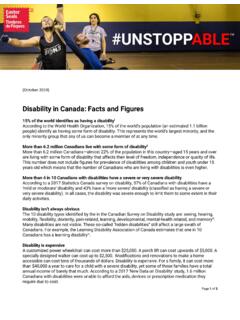Transcription of Disability in Canada: Facts and Figures - Easter Seals Canada
1 Disability in Canada : Facts and Figures 15% of the world identifies as having a Disability According to the World Health Organization, 15% of the world's population (an estimated billion people) identify as having some form of Disability . This represents the world's largest minority, and the only minority group that any of us can become a member of at any time. More than million Canadians live with some form of Disability According to Statistics Canada , more than million Canadians almost 16% of the population in this country are living with some form of Disability that affects their level of freedom, independence or quality of life. Of that number, over 200,000 are children and youth.
2 Disability isn't always obvious The 10 Disability types identified in the latest Canadian Survey on Disability study conducted by Statistics Canada are: seeing, hearing, mobility, flexibility, dexterity, pain, learning, developmental, mental/psychological, and memory. Many disabilities are not visible. These so-called "hidden disabilities" still affect a large swath of Canadians. For example, the Learning Disability Association of Canada estimates that one in 10 Canadians has a learning Disability . There's a real reliance on assistive technology According to Statistics Canada 's 2012 Canadian Survey on Disability , over 81% of people with disabilities reported using some kind of assistive technology or specialized equipment to help them move, communicate, learn or carry out the daily activities of life.
3 Disability is expensive A customized power wheelchair can cost more than $25,000. A porch lift can cost upwards of $5,000. A specially designed walker can cost up to $2,500. Modifications and renovations to make a home accessible can cost tens of thousands of dollars. Disability is expensive. For a family, it can cost more than $40,000 a year to care for a child with a severe Disability , yet some of these families have a total annual income of barely that much. There's a real education gap Proportionately, adults with disabilities were only about half as likely to get their university-level degrees as adults without disabilities, according to the Canadian Human Rights Commission ( vs.)
4 , respectively). Page 1 of 3. There's also a real wage gap According to a 2012 Canadian Human Rights Commission report, disabled men in the 15-to-64 age group earn $9,557 less than adult males in the same age group who don't have disabilities. Women between the ages of 15 to 64 earn $8,853 less. More people with disabilities are underemployed The unemployment rate for people with disabilities was , according to 2006 statistics, versus the Canadian average of Overall, more men with disabilities are settling for part-time work because they cannot find full-time employment, compared to adult men without disabilities who are working part-time hours, according to a 2012 CRHC report.
5 Proportionately, more women with disabilities work part-time but want to work full-time. More people with disabilities live in poverty The overall poverty rate for Canadian adults was in 2006, comprising million people. For people with disabilities the poverty rate was , comprising nearly 600,000 people. The 2012. Canadian Survey on Disability found that the self-reported median income of Canadians with disabilities was just over $20,000. Many companies aren't hiring people with disabilities Only three in 10 small business owners hired people with disabilities in 2013, matching levels from the previous year, according to a recent survey from BMO Financial Group.
6 The study, released last month, found that the majority of small businesses (69%) have never hired a person with a visible or invisible Disability . Employers report being happy with hiring those with disabilities Despite the lack of opportunity for candidates with disabilities, more than three-quarters of the employers surveyed by BMO in 2012 said that after recruiting disabled workers, the hires either met their expectations (62%) or exceeded them (15%). Canadians recognize there's a problem with inclusion According to 2004 Environics research, just 10% of Canadians believe people with disabilities are fully included in society. The majority of Canadians also want to help improve the lives of people with disabilities and agree the social benefit is worth the cost.
7 Million disabled adults need daily assistance More than million working-age adults (15 to 64) reported needing help with everyday physical activities in 2006, according to Statistics Canada . Page 2 of 3. Nearly half of Canadians believe in a hiring bias against disabled people Could hiding a Disability from a prospective employer boost a candidate's chances of getting hired? A. 2012 BMO study suggests that almost half of Canadians believe that could be the case, with 48% of all respondents saying that they believe candidates could be more likely to climb the corporate ladder if they kept their Disability under wraps. Many Canadians can't read The Canadian National Institute for the Blind estimated in 2011 that more than three million Canadians have a Disability that makes it difficult or impossible to read conventional print.
8 Students with disabilities are eligible for special loans The National Educational Association of Disabled Students has a website that lists information about awards and scholarships specifically for students with disabilities. The site is designed to make it easier for disabled students to search for relevant bursaries. Page 3 of 3.








